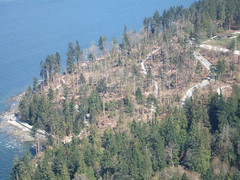Penmachine
15 April 2008
After a year and a half, Stanley Park surprised me
 With all my cancer treatments and so on, I have, remarkably, not been to Vancouver's famous Stanley Park since the vicious windstorm that hit Greater Vancouver near the end of 2006, a year and a half ago.
With all my cancer treatments and so on, I have, remarkably, not been to Vancouver's famous Stanley Park since the vicious windstorm that hit Greater Vancouver near the end of 2006, a year and a half ago.
Having been born and raised in this city, I think that's the longest time I've ever been away from the park in my entire life, until today. I was downtown for an errand, and decided to take a side trip in the car to drive through the park and see how things were going.
I was astonished. Toppled trees are still everywhere, and the stretch of Park Drive from Prospect Point to Third Beach is unrecognizable. What I always knew as a dense rainforest overhanging the road now comprises steep, open vistas across hundreds of broken trunks down to the ocean.
Rebecca at Miss604.com has been documenting the changes since the storm hit, so I had some idea what to expect—but not really. I'd like to take my bike down there sometime in the next few months and explore the trails again. In many ways, it's a whole different place now.
Labels: environment, history, park, vancouver, weather
Comments:
What we found surprising are the pockets of damage along Lovers' and Tatlow walks deep inside the park. There are big stretches where the park is undisturbed, and then you come to smaller areas were the trees are broken and splintered like matchsticks. It's reminiscent of the reverse of what tornadoes seem to do in the American midwest, where, among all the devastation, there are pockets of untouched areas. The closest I can come to an explanation is that there seem to have been little vortexes of very high winds in the small damaged areas in Stanley Park during that windstorm - maybe there were "mini-tornadoes".
Love,
Dad

